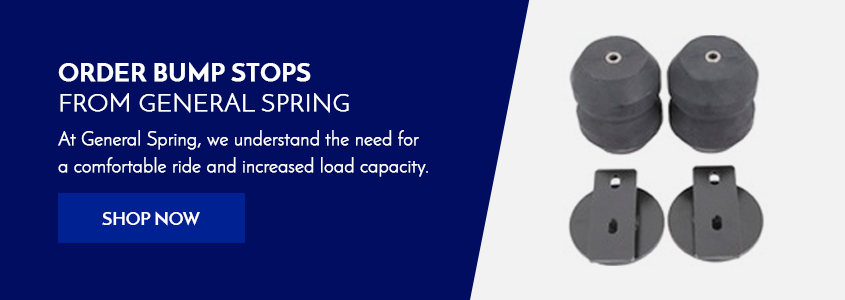Bump Stops and When to Upgrade or Replace
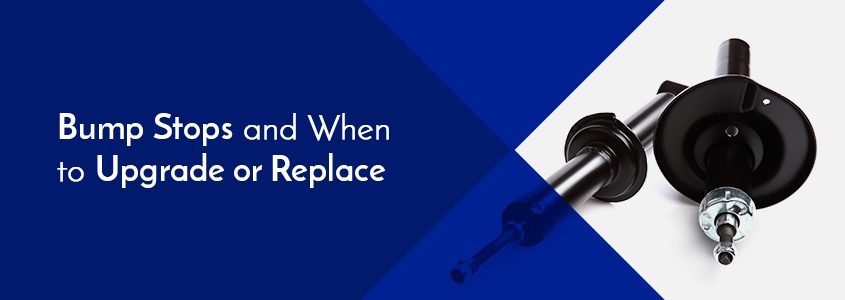
Bump stops are often overlooked, but they're some of the most important parts you can install to keep your ride comfortable and your suspension well-maintained. They're simple devices that can be installed quickly, but they have a major impact on your vehicle's suspension — especially if you take the vehicle off-roading or haul heavy materials. Drivers who want to reduce their vehicle's sway, improve roll stability, carry heavy loads and drive comfortably on uneven surfaces need to be familiar with bump stops.
In this guide, you can learn more about the signs that you need to replace your bump stops and who can benefit from them. We'll also cover how to install them, and the best bump stops available on the market today.
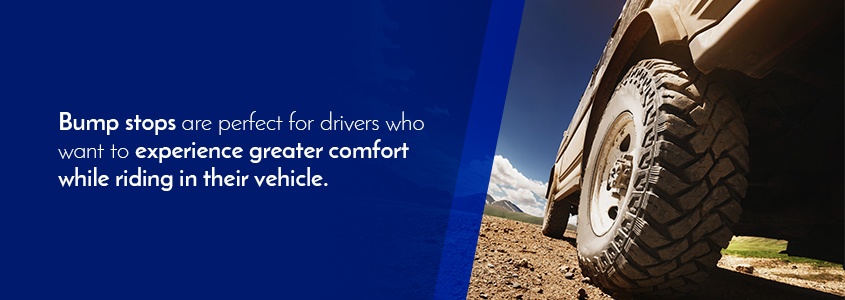

What Are Bump Stops?
Bump stops, otherwise known as jounce bumpers, are devices that are installed onto a vehicle's suspension system to provide shock absorption and extra cushion. Adding bump stops on a vehicle's suspension prevents the suspension's metal parts from rubbing against each other or coming into other kinds of contact that could be damaging.
Besides stopping metal suspension parts from coming into contact with each other, bump stops also limit an axle's upward movement. By limiting upward movement, the bump stops prevent the tires from making contact with the fender, whether that be rubbing or hitting against it. Bump stops also offer vehicle owners the ability to add longer shocks to their vehicles.
Bump stops can also keep the vehicle's suspension system and shock absorber in great condition since a bump stop bottoms out before the shocks do. Bottoming out without a bump stop can do some major damage to your vehicle, especially if you've used a lowering kit on the vehicle. A bump stop helps to soften the blow of bottoming out, protecting both your vehicle and the rider.
Who Needs a Bump Stop?
Bump stops are perfect for drivers who want to experience greater comfort while riding in their vehicle, no matter how uneven or tough the terrain they're taking their vehicle on. They're also great for drivers who want to provide extra protection to their suspension system.
If you're interested in keeping a vehicle's suspension system safe, bump stops are a great choice for almost any driver. However, they're particularly well-suited for off-road vehicles. Drivers who plan to take their truck out on unpaved roads or uneven terrains can especially benefit from bump stops as these surfaces make it more likely the vehicle bottoms out. For example, bump stops are a top choice for rock crawlers, as they soften landings and prevent shocks from bottoming out.
Those who want to go high speeds on uneven roads or terrains may also want bump stops, as high speeds place a great deal of impact force onto the suspension of the car. Regular shocks aren't going to absorb and control the energy being placed onto the suspension system. High-quality bump stops help to control the rebound energy and reduce strain on the vehicle's shocks. As a result, you get more control over your vehicle — even while passing over uneven terrain at high speeds.
Bump stops are also perfect for those with vehicles that regularly haul heavy-loads that place more pressure on their suspension system. For instance, truck bump stops for towing are important for absorbing the extra pressure that comes from hauling another vehicle from one location or another. Essentially, bump stops are crucial for anyone interested in improving the suspension system of their vehicle.
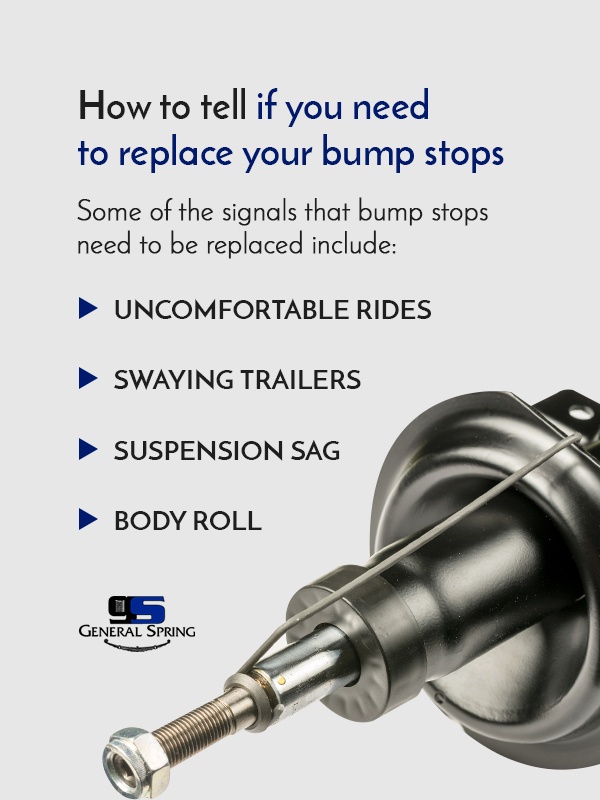
How to Tell If You Need to Replace Your Bump Stops
While bump stops are long-lasting, there are situations when they can crack or even disintegrate over time. You should check them occasionally for signs of damage to ensure they're still able to absorb impact and provide the protection your vehicle's suspension system needs.
If your bump stops have disintegrated or become damaged, you may notice it in the vehicle's performance. Some of the signals that bump stops need to be replaced include:
- Uncomfortable rides: Part of a bump stop's appeal is its ability to make vehicles more comfortable to ride in. If you take the truck on an uneven surface and your bump stops have broken down, your ride will be significantly less comfortable. Without bump stops, you'll feel every bump and pothole in the road.
- Swaying trailers: Some brands of bump stops help to increase roll stability when they sense vehicle movement. As such, trailer sway can be an indicator that your bump stop has disintegrated or cracked. Your trailer drifting when you pass heavy trucks or drive in crosswinds can be a major sign that your bump stops need to be replaced.
- Suspension sag: If you regularly haul heavy loads, bump stops are absolutely crucial since they absorb the weight and keep your vehicle from bottoming out from bumps. If you notice heavy loads are causing your rear or front suspensions to deflect lower than they should, you may want to see if your bump stops are damaged.
- Body roll: Bump stops can assist with proper weight distribution, which improves your steering, reduces tire and brake wear and keeps your vehicle level. If you notice your vehicle is leaning on curves and corners, you should check the bump stops right away to make sure they're not the culprit. You don't want to flip your vehicle or lose control of it while you are driving, so it's important to keep on top of your bump stop's quality.
If you don't regularly go over uneven surfaces or haul heavy loads, you may not notice if your bump stops become damaged. Since you may not immediately notice damage by driving the vehicle, you should make sure to include checking your bump stops in your routine maintenance checks.
In addition to replacing bump stops due to damage, you may want to replace them if you want to go with a better brand that can provide superior protection for your vehicle. For example, a Timbren bump stop is a premier type of bump stop that is designed to work with heavy hauler trucks. Because Timbren bump stops are made out of rubber, you won't need to invest time in maintaining them like you would with airbag helper springs that accomplish the same function.
Timbren bump stops also tend to replace other types of bump stops when a driver wants their vehicle to haul or use heavy equipment or materials. They also help keep your vehicle safe when using front applications like snowplows or rear applications like trailers that add extra weight to your vehicle. Since Timbren bump stops are known for being able to engage with heavy loads and disengage with lower weighted loads, they're often favorites with drivers.
How to Locate Your Bump Stop
Bump stops can be mounted in different places, so locating them in your vehicle or finding the place to install new ones will vary. One primary bump stop location is in the area that's in line with the vehicle's piston rods of the shock. Placing bump stops in these locations helps to add more absorption whenever the shock hits its limit.
Another kind of bump stop that is sometimes referred to as an axle snubber can be installed between the vehicle's axle and frame. This type of bump stop helps absorb any impact that would normally cause the axle to make contact and slam against the frame.
Depending on the type of bump stop you choose to include, you should check to see where the manufacturer recommends you install it. For example, if you're installing a Timbren bump stop on your truck, you need to place it on the underside of the truck right above the rear axle.
How to Install or Replace Your Bump Stop
While there may be some differences in the type of bump stop you choose to install, we'll be covering how to install one of the best types: a rubber bump stop. Specifically, we'll be describing how to install a Timbren bump stop kit, but much of the process can be applied to other brands.
Even if you're not skilled mechanically, you can likely complete this replacement within a couple of hours with a DIY car project. The following steps should cover a standard bump stop installation:
- Brace the tires to ensure your vehicle doesn't begin rolling away during the installation process. You'll need to get under your car during the installation, so it's important for your safety to ensure the vehicle won't move while you're under it.
- After bracing the tires, use a jack at the end of your needed axle to elevate the vehicle. If you have trouble accessing the underside area where the bump stops are installed, you can also remove the elevated wheels to work more freely.
- If you have an older bump stop you're replacing, you should unfasten it at this point. Once you've unfastened the original bump stop, there should be a few newly freed holes where the old bump stop used to be.
- Before you install the bump stop, you need to get the Timbren kit ready. To do this, push the bolt through the washer and then up through the Timbren springs. Next, connect the bump stop to the brackets.
- With your kit ready, you can then install the new bump stop into the area where the old bump stop was. If your vehicle doesn't have a bump stop originally installed, you'll install the new one wherever the manufacturer states it can be installed in the front and rear of the vehicle.
- Those who have trouble attaching the bump stop can try to make it a better fit by using soap to lubricate the holes. You can also put a wood block down under the bump stop. After the wood block is in place, you can take the suspension down slightly so the bump stop makes contact with the wood block, causing the bump stop to be pressed into place.
- To finish the installation, you simply secure your fasteners and reattach your tires if you removed them. You'll repeat the process on the other side of the vehicle to ensure your bump stops are evenly distributed.
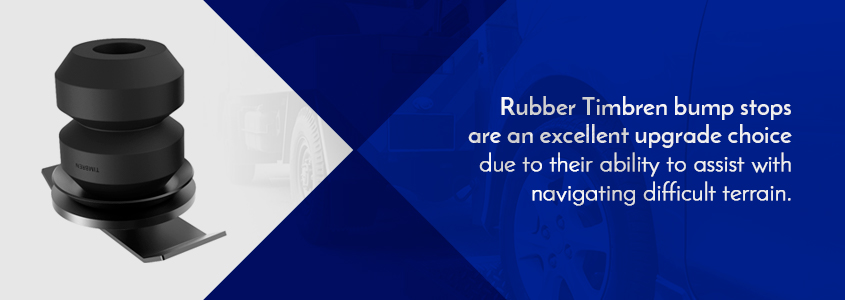
How to Upgrade Bump Stops for Towing
When a truck tows trailers, boats and other heavy loads, a great deal of stress is placed on its suspension system. Over time, this amount of weight can be incredibly taxing on your suspension, leading to maintenance issues and causing it to be unsafe when towing high-weight loads. Additionally, a vehicle that doesn't have proper bump stops installed can have issues with trailer sway while on the road, potentially putting the driver and everyone else on the road at risk of an accident.
If you're interested in towing heavy loads, you should turn to suspension kits that come with all the overload bumpers you could need. Timbren rubber bump stops are designed to handle heavy loads. As such, they make a favorite choice for those who want to upgrade their bump stops. They're designed to adjust automatically to heavy or light loads, meaning you don't have to spend time adjusting the bump stops for loads of varying weights like you would with suspension airbags.
Timbren bump stops take the stress of the weight away from the underside of the towing vehicle. As a result of absorbing the weight, these bump stops protect your leaf springs and axle from the chassis's weight whenever your vehicle begins to slump in the rear due to heavy loads.
Rubber Timbren bump stops are an excellent upgrade choice due to their ability to assist with navigating difficult terrain. These bump stops assist with inclines and sharp turns where trucks without bump stops might sway or experience body roll due to the extra weight from a heavy haul. Timbren bump stops keep the vehicle stable, even on the most difficult terrain.
Order Bump Stops From General Spring
If you're ready to upgrade your truck with a bump stop, you need to work with a supplier who's ready to provide you with the best bump stops available and get them to you quickly with fast shipping. At General Spring, we understand the need for a comfortable ride and increased load capacity. That's why we offer premium Timbren bump stops and Timbren suspension kits that are designed for load boosting to protect your vehicle's leaf springs and axles from excess weight.
Browse our selection of Timbren bump stops to find the perfect fit for your vehicle. Contact us today if you have any questions about bump stops or any other pieces of equipment offered in our inventory.
Bump Stops and When to Upgrade or Replace

Bump stops are often overlooked, but they're some of the most important parts you can install to keep your ride comfortable and your suspension well-maintained. They're simple devices that can be installed quickly, but they have a major impact on your vehicle's suspension — especially if you take the vehicle off-roading or haul heavy materials. Drivers who want to reduce their vehicle's sway, improve roll stability, carry heavy loads and drive comfortably on uneven surfaces need to be familiar with bump stops.
In this guide, you can learn more about the signs that you need to replace your bump stops and who can benefit from them. We'll also cover how to install them, and the best bump stops available on the market today.


What Are Bump Stops?
Bump stops, otherwise known as jounce bumpers, are devices that are installed onto a vehicle's suspension system to provide shock absorption and extra cushion. Adding bump stops on a vehicle's suspension prevents the suspension's metal parts from rubbing against each other or coming into other kinds of contact that could be damaging.
Besides stopping metal suspension parts from coming into contact with each other, bump stops also limit an axle's upward movement. By limiting upward movement, the bump stops prevent the tires from making contact with the fender, whether that be rubbing or hitting against it. Bump stops also offer vehicle owners the ability to add longer shocks to their vehicles.
Bump stops can also keep the vehicle's suspension system and shock absorber in great condition since a bump stop bottoms out before the shocks do. Bottoming out without a bump stop can do some major damage to your vehicle, especially if you've used a lowering kit on the vehicle. A bump stop helps to soften the blow of bottoming out, protecting both your vehicle and the rider.
Who Needs a Bump Stop?
Bump stops are perfect for drivers who want to experience greater comfort while riding in their vehicle, no matter how uneven or tough the terrain they're taking their vehicle on. They're also great for drivers who want to provide extra protection to their suspension system.
If you're interested in keeping a vehicle's suspension system safe, bump stops are a great choice for almost any driver. However, they're particularly well-suited for off-road vehicles. Drivers who plan to take their truck out on unpaved roads or uneven terrains can especially benefit from bump stops as these surfaces make it more likely the vehicle bottoms out. For example, bump stops are a top choice for rock crawlers, as they soften landings and prevent shocks from bottoming out.
Those who want to go high speeds on uneven roads or terrains may also want bump stops, as high speeds place a great deal of impact force onto the suspension of the car. Regular shocks aren't going to absorb and control the energy being placed onto the suspension system. High-quality bump stops help to control the rebound energy and reduce strain on the vehicle's shocks. As a result, you get more control over your vehicle — even while passing over uneven terrain at high speeds.
Bump stops are also perfect for those with vehicles that regularly haul heavy-loads that place more pressure on their suspension system. For instance, truck bump stops for towing are important for absorbing the extra pressure that comes from hauling another vehicle from one location or another. Essentially, bump stops are crucial for anyone interested in improving the suspension system of their vehicle.

How to Tell If You Need to Replace Your Bump Stops
While bump stops are long-lasting, there are situations when they can crack or even disintegrate over time. You should check them occasionally for signs of damage to ensure they're still able to absorb impact and provide the protection your vehicle's suspension system needs.
If your bump stops have disintegrated or become damaged, you may notice it in the vehicle's performance. Some of the signals that bump stops need to be replaced include:
- Uncomfortable rides: Part of a bump stop's appeal is its ability to make vehicles more comfortable to ride in. If you take the truck on an uneven surface and your bump stops have broken down, your ride will be significantly less comfortable. Without bump stops, you'll feel every bump and pothole in the road.
- Swaying trailers: Some brands of bump stops help to increase roll stability when they sense vehicle movement. As such, trailer sway can be an indicator that your bump stop has disintegrated or cracked. Your trailer drifting when you pass heavy trucks or drive in crosswinds can be a major sign that your bump stops need to be replaced.
- Suspension sag: If you regularly haul heavy loads, bump stops are absolutely crucial since they absorb the weight and keep your vehicle from bottoming out from bumps. If you notice heavy loads are causing your rear or front suspensions to deflect lower than they should, you may want to see if your bump stops are damaged.
- Body roll: Bump stops can assist with proper weight distribution, which improves your steering, reduces tire and brake wear and keeps your vehicle level. If you notice your vehicle is leaning on curves and corners, you should check the bump stops right away to make sure they're not the culprit. You don't want to flip your vehicle or lose control of it while you are driving, so it's important to keep on top of your bump stop's quality.
If you don't regularly go over uneven surfaces or haul heavy loads, you may not notice if your bump stops become damaged. Since you may not immediately notice damage by driving the vehicle, you should make sure to include checking your bump stops in your routine maintenance checks.
In addition to replacing bump stops due to damage, you may want to replace them if you want to go with a better brand that can provide superior protection for your vehicle. For example, a Timbren bump stop is a premier type of bump stop that is designed to work with heavy hauler trucks. Because Timbren bump stops are made out of rubber, you won't need to invest time in maintaining them like you would with airbag helper springs that accomplish the same function.
Timbren bump stops also tend to replace other types of bump stops when a driver wants their vehicle to haul or use heavy equipment or materials. They also help keep your vehicle safe when using front applications like snowplows or rear applications like trailers that add extra weight to your vehicle. Since Timbren bump stops are known for being able to engage with heavy loads and disengage with lower weighted loads, they're often favorites with drivers.
How to Locate Your Bump Stop
Bump stops can be mounted in different places, so locating them in your vehicle or finding the place to install new ones will vary. One primary bump stop location is in the area that's in line with the vehicle's piston rods of the shock. Placing bump stops in these locations helps to add more absorption whenever the shock hits its limit.
Another kind of bump stop that is sometimes referred to as an axle snubber can be installed between the vehicle's axle and frame. This type of bump stop helps absorb any impact that would normally cause the axle to make contact and slam against the frame.
Depending on the type of bump stop you choose to include, you should check to see where the manufacturer recommends you install it. For example, if you're installing a Timbren bump stop on your truck, you need to place it on the underside of the truck right above the rear axle.
How to Install or Replace Your Bump Stop
While there may be some differences in the type of bump stop you choose to install, we'll be covering how to install one of the best types: a rubber bump stop. Specifically, we'll be describing how to install a Timbren bump stop kit, but much of the process can be applied to other brands.
Even if you're not skilled mechanically, you can likely complete this replacement within a couple of hours with a DIY car project. The following steps should cover a standard bump stop installation:
- Brace the tires to ensure your vehicle doesn't begin rolling away during the installation process. You'll need to get under your car during the installation, so it's important for your safety to ensure the vehicle won't move while you're under it.
- After bracing the tires, use a jack at the end of your needed axle to elevate the vehicle. If you have trouble accessing the underside area where the bump stops are installed, you can also remove the elevated wheels to work more freely.
- If you have an older bump stop you're replacing, you should unfasten it at this point. Once you've unfastened the original bump stop, there should be a few newly freed holes where the old bump stop used to be.
- Before you install the bump stop, you need to get the Timbren kit ready. To do this, push the bolt through the washer and then up through the Timbren springs. Next, connect the bump stop to the brackets.
- With your kit ready, you can then install the new bump stop into the area where the old bump stop was. If your vehicle doesn't have a bump stop originally installed, you'll install the new one wherever the manufacturer states it can be installed in the front and rear of the vehicle.
- Those who have trouble attaching the bump stop can try to make it a better fit by using soap to lubricate the holes. You can also put a wood block down under the bump stop. After the wood block is in place, you can take the suspension down slightly so the bump stop makes contact with the wood block, causing the bump stop to be pressed into place.
- To finish the installation, you simply secure your fasteners and reattach your tires if you removed them. You'll repeat the process on the other side of the vehicle to ensure your bump stops are evenly distributed.

How to Upgrade Bump Stops for Towing
When a truck tows trailers, boats and other heavy loads, a great deal of stress is placed on its suspension system. Over time, this amount of weight can be incredibly taxing on your suspension, leading to maintenance issues and causing it to be unsafe when towing high-weight loads. Additionally, a vehicle that doesn't have proper bump stops installed can have issues with trailer sway while on the road, potentially putting the driver and everyone else on the road at risk of an accident.
If you're interested in towing heavy loads, you should turn to suspension kits that come with all the overload bumpers you could need. Timbren rubber bump stops are designed to handle heavy loads. As such, they make a favorite choice for those who want to upgrade their bump stops. They're designed to adjust automatically to heavy or light loads, meaning you don't have to spend time adjusting the bump stops for loads of varying weights like you would with suspension airbags.
Timbren bump stops take the stress of the weight away from the underside of the towing vehicle. As a result of absorbing the weight, these bump stops protect your leaf springs and axle from the chassis's weight whenever your vehicle begins to slump in the rear due to heavy loads.
Rubber Timbren bump stops are an excellent upgrade choice due to their ability to assist with navigating difficult terrain. These bump stops assist with inclines and sharp turns where trucks without bump stops might sway or experience body roll due to the extra weight from a heavy haul. Timbren bump stops keep the vehicle stable, even on the most difficult terrain.
Order Bump Stops From General Spring
If you're ready to upgrade your truck with a bump stop, you need to work with a supplier who's ready to provide you with the best bump stops available and get them to you quickly with fast shipping. At General Spring, we understand the need for a comfortable ride and increased load capacity. That's why we offer premium Timbren bump stops and Timbren suspension kits that are designed for load boosting to protect your vehicle's leaf springs and axles from excess weight.
Browse our selection of Timbren bump stops to find the perfect fit for your vehicle. Contact us today if you have any questions about bump stops or any other pieces of equipment offered in our inventory.

